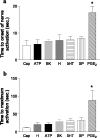Adenosine 5'-triphosphate and its relationship with other mediators that activate pelvic nerve afferent neurons in the rat colorectum
- PMID: 18404489
- PMCID: PMC2104004
- DOI: 10.1007/s11302-005-5305-2
Adenosine 5'-triphosphate and its relationship with other mediators that activate pelvic nerve afferent neurons in the rat colorectum
Abstract
Evidence of a role for purinergic signalling in visceral afferents involving P2X(2), P2X(3) and P2Y(1) receptors exists, which appears to be important during inflammation. This study aimed to evaluate the degree of interaction between adenosine 5'-triphosphate (ATP) and other mediators that activate sensory nerves in the colorectum. Recordings from pelvic nerve afferents were made during application of agents to the in-vitro colorectal preparation. Analysis allowed calculation of single unit activity. When applied individually, bradykinin (78%) and 5-hydoxytryptamine (77%) activated the greatest number of neurons, followed by substance P, protons, ATP and capsaicin. Prostaglandin E(2) stimulated the least number (54%) and had a longer latency. Seventy-seven percent of all units studied either responded to both ATP and capsaicin or to neither, giving the greatest degree of activity correlation. Five percent of units were activated by all seven agents and no units were activated by a single agent alone. 5-hydroxytryptamine, capsaicin and protons, when co-applied with ATP, increased pelvic nerve activity to a greater degree than the sum of the individual responses. It is concluded that ATP activates pelvic nerve afferents and acts synergistically with protons, capsaicin and 5-hydroxytryptamine. The pattern of neuronal activation suggests that visceral afferents are polymodal but the receptor expression on their terminals is variable.
Figures







Similar articles
-
P2X purinoceptor-mediated excitation of trigeminal lingual nerve terminals in an in vitro intra-arterially perfused rat tongue preparation.J Physiol. 2000 May 1;524 Pt 3(Pt 3):891-902. doi: 10.1111/j.1469-7793.2000.00891.x. J Physiol. 2000. PMID: 10790166 Free PMC article.
-
Purinergic mechanisms contribute to mechanosensory transduction in the rat colorectum.Gastroenterology. 2003 Nov;125(5):1398-409. doi: 10.1016/j.gastro.2003.07.008. Gastroenterology. 2003. PMID: 14598256
-
Involvement of peripheral purinoceptors in sympathetic modulation of capsaicin-induced sensitization of primary afferent fibers.J Neurophysiol. 2006 Nov;96(5):2207-16. doi: 10.1152/jn.00502.2006. Epub 2006 Aug 2. J Neurophysiol. 2006. PMID: 16885522
-
Connections between P2 purinoceptors and capsaicin-sensitive afferents in the intestine and other tissues.Eur J Pharmacol. 1999 Jun 30;375(1-3):203-10. doi: 10.1016/s0014-2999(99)00253-8. Eur J Pharmacol. 1999. PMID: 10443576 Review.
-
Adenosine in the spinal cord and periphery: release and regulation of pain.Prog Neurobiol. 2003 Apr;69(5):313-40. doi: 10.1016/s0301-0082(03)00050-9. Prog Neurobiol. 2003. PMID: 12787573 Review.
Cited by
-
Purine and purinergic receptors.Brain Neurosci Adv. 2018 Dec 6;2:2398212818817494. doi: 10.1177/2398212818817494. eCollection 2018 Jan-Dec. Brain Neurosci Adv. 2018. PMID: 32166165 Free PMC article. Review.
-
P2X3 receptors mediate visceral hypersensitivity during acute chemically-induced colitis and in the post-inflammatory phase via different mechanisms of sensitization.PLoS One. 2015 Apr 17;10(4):e0123810. doi: 10.1371/journal.pone.0123810. eCollection 2015. PLoS One. 2015. PMID: 25885345 Free PMC article.
-
Purinergic mechanosensory transduction and visceral pain.Mol Pain. 2009 Nov 30;5:69. doi: 10.1186/1744-8069-5-69. Mol Pain. 2009. PMID: 19948030 Free PMC article. Review.
-
Mechanosensory Signaling in Enterochromaffin Cells and 5-HT Release: Potential Implications for Gut Inflammation.Front Neurosci. 2016 Dec 19;10:564. doi: 10.3389/fnins.2016.00564. eCollection 2016. Front Neurosci. 2016. PMID: 28066160 Free PMC article. Review.
References
-
- {'text': '', 'ref_index': 1, 'ids': [{'type': 'PubMed', 'value': '10823099', 'is_inner': True, 'url': 'https://pubmed.ncbi.nlm.nih.gov/10823099/'}]}
- Burnstock G. P2X receptors in sensory neurones. Br J Anaesth 2000; 84: 476–8. - PubMed
-
- {'text': '', 'ref_index': 1, 'ids': [{'type': 'DOI', 'value': '10.1006/mcne.1998.0719', 'is_inner': False, 'url': 'https://doi.org/10.1006/mcne.1998.0719'}, {'type': 'PubMed', 'value': '9828090', 'is_inner': True, 'url': 'https://pubmed.ncbi.nlm.nih.gov/9828090/'}]}
- Bradbury EJ, Burnstock G, McMahon SB. The expression of P2X3 purinoreceptors in sensory neurons: Effects of axotomy and glial-derived neurotrophic factor. Mol Cell Neurosci 1998; 12: 256–8. - PubMed
-
- {'text': '', 'ref_index': 1, 'ids': [{'type': 'DOI', 'value': '10.1016/S0301-0082(01)00005-3', 'is_inner': False, 'url': 'https://doi.org/10.1016/s0301-0082(01)00005-3'}, {'type': 'PubMed', 'value': '11403876', 'is_inner': True, 'url': 'https://pubmed.ncbi.nlm.nih.gov/11403876/'}]}
- Dunn PM, Zhong Y, Burnstock G. P2X receptors in peripheral neurones. Prog Neurobiol 2001; 65: 107–4. - PubMed
-
- {'text': '', 'ref_index': 1, 'ids': [{'type': 'DOI', 'value': '10.1007/s00418-003-0579-3', 'is_inner': False, 'url': 'https://doi.org/10.1007/s00418-003-0579-3'}, {'type': 'PubMed', 'value': '14564529', 'is_inner': True, 'url': 'https://pubmed.ncbi.nlm.nih.gov/14564529/'}]}
- Ruan H, Burnstock G. Localisation of P2Y1 and P2Y4 receptors in dorsal root, nodose and trigeminal ganglia of the rat. Histochem Cell Biol 2003; 120: 415–6. - PubMed
-
- {'text': '', 'ref_index': 1, 'ids': [{'type': 'DOI', 'value': '10.1046/j.1469-7580.1999.19430335.x', 'is_inner': False, 'url': 'https://doi.org/10.1046/j.1469-7580.1999.19430335.x'}, {'type': 'PMC', 'value': 'PMC1467933', 'is_inner': False, 'url': 'https://pmc.ncbi.nlm.nih.gov/articles/PMC1467933/'}, {'type': 'PubMed', 'value': '10386771', 'is_inner': True, 'url': 'https://pubmed.ncbi.nlm.nih.gov/10386771/'}]}
- Burnstock G. Release of vasoactive substances from endothelial cells by shear stress and purinergic mechanosensory transduction. J Anat 1999; 194: 335–2. - PMC - PubMed
LinkOut - more resources
Full Text Sources

